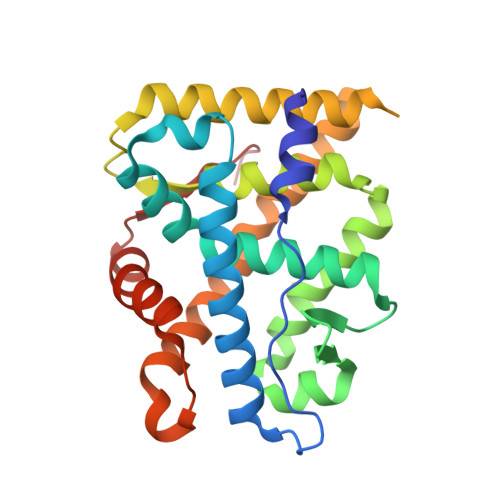Mechanisms for the evolution of a derived function in the ancestral glucocorticoid receptor.
Carroll, S.M., Ortlund, E.A., Thornton, J.W.(2011) PLoS Genet 7: e1002117-e1002117
- PubMed: 21698144
- DOI: https://doi.org/10.1371/journal.pgen.1002117
- Primary Citation of Related Structures:
3RY9 - PubMed Abstract:
Understanding the genetic, structural, and biophysical mechanisms that caused protein functions to evolve is a central goal of molecular evolutionary studies. Ancestral sequence reconstruction (ASR) offers an experimental approach to these questions. Here we use ASR to shed light on the earliest functions and evolution of the glucocorticoid receptor (GR), a steroid-activated transcription factor that plays a key role in the regulation of vertebrate physiology. Prior work showed that GR and its paralog, the mineralocorticoid receptor (MR), duplicated from a common ancestor roughly 450 million years ago; the ancestral functions were largely conserved in the MR lineage, but the functions of GRs-reduced sensitivity to all hormones and increased selectivity for glucocorticoids-are derived. Although the mechanisms for the evolution of glucocorticoid specificity have been identified, how reduced sensitivity evolved has not yet been studied. Here we report on the reconstruction of the deepest ancestor in the GR lineage (AncGR1) and demonstrate that GR's reduced sensitivity evolved before the acquisition of restricted hormone specificity, shortly after the GR-MR split. Using site-directed mutagenesis, X-ray crystallography, and computational analyses of protein stability to recapitulate and determine the effects of historical mutations, we show that AncGR1's reduced ligand sensitivity evolved primarily due to three key substitutions. Two large-effect mutations weakened hydrogen bonds and van der Waals interactions within the ancestral protein, reducing its stability. The degenerative effect of these two mutations is extremely strong, but a third permissive substitution, which has no apparent effect on function in the ancestral background and is likely to have occurred first, buffered the effects of the destabilizing mutations. Taken together, our results highlight the potentially creative role of substitutions that partially degrade protein structure and function and reinforce the importance of permissive mutations in protein evolution.
- Department of Organismic and Evolutionary Biology, Harvard University, Cambridge, Massachusetts, USA.
Organizational Affiliation:



















